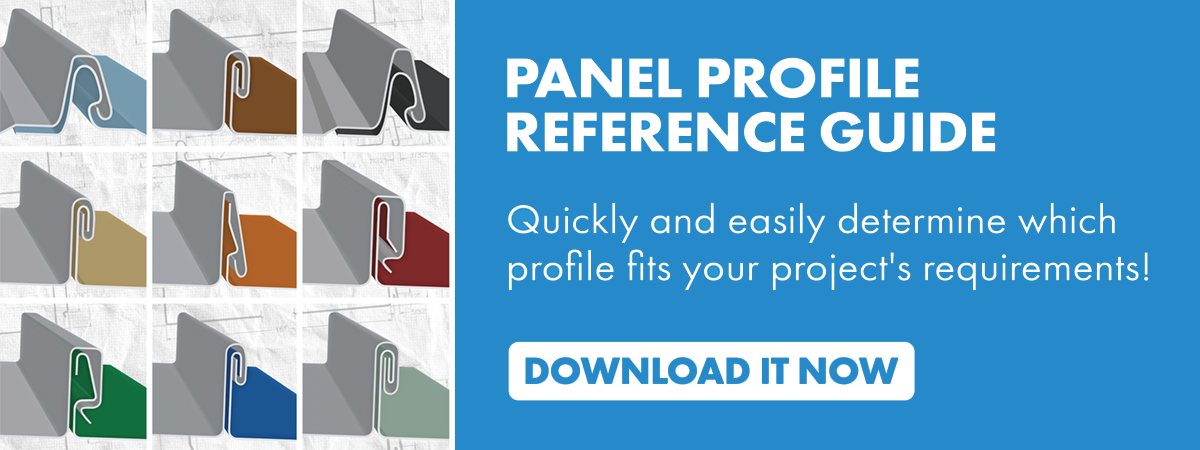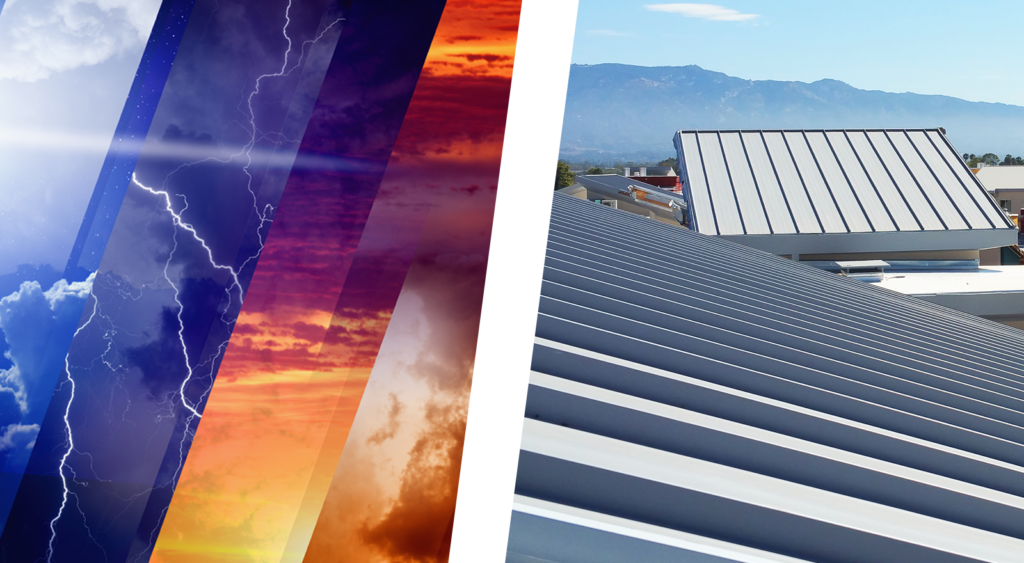Fastener flange, also known as nail strip or nail flange, panel profiles are popular options in the residential metal roofing market.
While fastener flange profiles don’t traditionally have the same level of engineering as typical mechanical lock or snap-lock panels, they’re still suitable for various roofing applications. Plus, nail strip systems come in at a lower price point, making it a more affordable roof product that is a longer-lasting solution to asphalt shingles in the right application.
One such fastener flange profile is the Sheffield Metals 1.0” Fastener Flange SnapLock, a standard system used by contractors and manufacturers for residential projects.
Sheffield Metals has focused on offering engineered and non-engineered standing seam profiles for metal roof and wall systems, including the 1.0” Fastener Flange SnapLock. Whether your project is residential or commercial, big or small, solid decking or otherwise – we have a panel profile that will work for you.
So, let’s discuss the SMI 1.0” Fastener Flange SnapLock profile, its specifications, when to use it, and when not to use it.
Sheffield Metals 1.0” Fastener Flange SnapLock Specifications
The Sheffield Metals 1.0” Fastener Flange SnapLock profile goes by a few different names or nicknames, including:
- SMI 1.0” Fastener Flange
- SMI 1.0” FF
- 1.0” FF SnapLock
- 1.0” FF
- 1.0” nail strip or nail flange

Keep in mind that there are various 1.0” fastener flange profiles that other manufacturers offer or sell. For this article, we are ONLY discussing the Sheffield Metals 1.0” Fastener Flange profile. Please refer to a specific manufacturer’s specifications for details on their 1” nail strip profile options.
Panel & Seam Type
The Sheffield Metals 1.0” Fastener Flange SnapLock profile is a standing seam panel type attached to the roof deck through a nail strip on the panel. Instead of using a clip, each panel is directly fastened down to the deck through a notch in the panel’s male leg or the space between notches on the male leg. Once the male leg is fastened down, the female leg of the panel snaps over the entirety of the male leg to hide the fastener head.
While this sounds similar to other snap-lock profiles, such as the SMI 1.75” SnapLock, it’s significantly different. A true snap-lock profile is attached to the deck via clips that do not penetrate the metal’s surface. This profile takes all clips out of the system and directly pins the panels to the decking structure.
Metal Materials
The SMI 1.0” Fastener Flange SnapLock can be rollformed with steel (Galvalume®); in fact, our UL 90 Construction Number is good down to 29-gauge Galvalume. You can also use the same metal materials in a thicker gauge or a narrower width panel.
Panel & Coil Width
On the 1.0” FF profile, the finished panel width for our UL 90 Construction Number is 16” for Galvalume ONLY. This specific panel requires approximately 4-1/16” of metal sheet or coil to rollform the panel legs.
If you rollform your panels or plan to use on-site portable rollforming, you will use a 20” coil. This profile has a maximum coil width of 24”.
For reference, if you take the square footage of the roof and multiply it by 1.25, it will equal the total amount of coil needed to manufacture SMI 1.0” FF SnapLock panels. Keep in mind: This calculation doesn’t account for the waste factor.
Seam Height
The seam height for this profile is 1.0 inches.
Slope Minimum & Requirements
The slope minimum for the 1.0” Fastener Flange profile is 3/12.

This article’s “When to Use the SMI 1.0” Fastener Flange SnapLock Profile” section will discuss slope requirements more in detail.
Roof Deck Substrates
For the UL 90 Construction Number requirements, you can install the SMI 1.0” FF assembly on a plywood roof deck only.
Weathertight Warranties
The SMI 1.0” FF SnapLock panel profile does NOT qualify for weathertight warranties from Sheffield Metals.
Paint & Substrate Warranties
Galvalume SMI 1.0” Fastener Flange SnapLock roof systems carry a 40-year transferable PVDF paint/finish warranty (available from Sherwin-Williams). Additionally, substrate warranties are available; warranty length, inclusions, and exclusions will vary depending on the material type and project location.
Installation Details
The SMI 1.0” FF profile has installation details for steel systems installed over plywood. Metal roof installation details provide an in-depth product guide detailing the location of accessories and explain the basic practical installation methods for these products at various points on the roof.
As always, make sure to follow the guidelines as to what deck substrate you can install over, approved products, and other additional requirements. Please visit the profile product page to download the 1.0” Fastener Flange SnapLock installation details.
Miscellaneous Specifications & Requirements
There are a few other elements that are specific to the SMI 1.0” FF profile, including:
- Panel surface options: Smooth or embossed (optional)
- Panel clip requirement(s): None
- Compatible S-5! attachment clamp(s): S-5-N and S-5-N Mini
- NOTE: We strongly recommend using clip relief to avoid the fastener transferring through the metal or an ultra-low-profile pancake head fastener, or both.

Engineering, Testing, & Approvals on the SMI 1.0” Fastener Flange SnapLock Profile
UL 90 Construction Number
SMI 1.0″ FF SnapLock UL 90 Test – Construction No. 529
- 24″ wide 29-gauge panel over plywood
- There is no actual testing on this profile at this time
Impact Resistance Testing: UL 2218 (Impact Resistance of Prepared Roof Covering Materials)
Substrate material(s): Steel and aluminum
Result: Class 4 (best rating / most likely to resist surface penetrations based on testing criteria)
Fire Rating: UL 790 (Standard for Standard Test Methods for Fire Tests of Roof Coverings)
Substrate material: Steel and aluminum
Result: Class A when installed per tested assembly (best rating / least likely to combust or catch fire)
Texas Department of Insurance (TDI)
Substrate material: Steel
Deck types: Plywood
Result: Approved
When to Use the SMI 1.0” Fastener Flange SnapLock Profile
Your project has a steep-slope roof — The SMI 1.0” Fastener Flange profile is suitable for use on steep-slope roofing applications, as nail strip snap-lock systems are only suited for hydrokinetic roof conditions. For reference, hydrokinetic conditions are when water is quickly shedding off the roof plane. Hydrokinetic systems are typically any roof pitch above a 3/12, which is in line with the slope requirements of the 1.0” FF profile.

Your project is residential — We recommend using the SMI 1.0” FF SnapLock profile on residential properties only. This profile is still a good option for metal roofing if you are looking to avoid the look of exposed fasteners and do not have the budget for a clipped system.
You’re looking for a more economical residential metal roof — In general, fastener flange profiles are the more economical option for standing seam metal roofing. There are several reasons this profile is cheaper:
- First, you don’t have to pay for the clips to attach the panels to the deck, which means there should be cost savings on materials.
- Second, this panel is relatively easy to install and takes significantly less time to complete. It’s more efficient because the legs just snap together after the panel is fastened down and doesn’t require any hand or robotic seaming.
Your project has shorter panel lengths — Due to the pinning and thermal movement concerns, the panel length for the 1.0” Fastener Flange SnapLock manufactured in Galvalume is limited to a maximum length of 25 ft. This makes it a good option for metal roof accents that are standing seam systems.
You’re a DIY homeowner installing your roof — There are some metal roofs that skilled DIYers can install — and the 1.0” Fastener Flange is often one of them. While this profile still requires a professional to rollform the panels, a DIYer can install the panels with some roofing knowledge. That being said, snaplock panels are relatively easy to install but you still have all of your trim details to contend with. We always recommend that you hire a skilled metal roofing professional to install your critically important metal roofing structure. It’s often not worth risking a roof failure that causes significant property damage.
You use poor details, such as a C-Zee — The nice thing about a fastener flange system is that you can use inferior installation details without the risk of the panels sliding off the roof under load, as the system panel is repeatedly fastened directly to the roof deck. A C-Zee will allow for quicker installations; however, it is strongly discouraged by most metal roof manufacturers throughout the industry.
When NOT to Use the SMI 1.0” Fastener Flange SnapLock Profile
You need an engineered standing seam roofing system — The SMI 1.0” Fastener Flange profile is considered a non-engineered profile, according to our engineering requirements. This profile does have the standard impact resistance and fire rating testing that all of our profiles have (this is due to the quality of the metal, not the profile). Still, it’s not tested to withstand uplifting, water penetration, air or water infiltration, wind-driven rain, foot traffic, and beyond. It does have TDI approval and one UL 90 Construction Number; however, it doesn’t qualify as an engineered system.

Your project is in a region with extreme weather threats — Due to its non-engineered label, this profile isn’t suitable for any residential or commercial structures in extreme weather regions. If you live in a region with threats of hurricanes, tornados, extreme heat, or significant snowfall/precipitation, the 1.0” FF profile is likely not the best choice.
The roof is only held onto the structure with fastener flange profiles by a fastener head and a 24 gauge slot. If the panel is exposed to the right amount of force, the metal can rip away from the fastener head, come loose, or even detach from the roof. Additionally, pinned panels can limit the expansion and contraction needed for adequate thermal movement, which adds stress to the metal and can lead to oil canning or other metal roofing problems.
If you live in a region with strong weather potential, choosing a different, more engineered profile would be best.
Your project requires a weathertight warranty — The 1.0” FF profile does not qualify for weathertight warranties, as there is no testing to verify how well it’ll perform. Plus, weathertight warranties are only available for commercial structures, and the 1.0” FF is not suited for commercial roofs.
Your project requires longer panels — Due to the pinning and thermal movement concerns, this profile’s panel length is limited to a maximum of 25 ft.
Your roof structure is low-slope — As discussed, the 1.0” FF SnapLock profile is not applicable on roof slopes at or below a 3/12.
Your roof deck is not in plane — Since fastener flange panels are attached directly to the roof deck, they will follow the roof deck and all of its imperfections. This can cause oil canning and, in severe cases, will make it very difficult for the panels to engage.
Your roof has an open-framing assembly — As with many snap-lock systems, it is best to only install them on solid roof decks — the fastener flange is no exception. Additionally, a clip interface will inherently add strength to the system, and the fastener flange is relying on the holding strength of the metal panel leg to remain engaged.
If you have the budget for a higher quality roof system — We’ll say what many are afraid to: If you have the budget to get a standing seam metal roof system, just get a better-performing option (such as a snap-lock or mechanically seamed profile). The upcharge is usually pretty minimal, it will be more aesthetically pleasing, and it will hold up better in harsh weather environments.
Completed Project(s) Using the SMI 1.0″ FF
Final Thoughts on the SMI 1.0” Fastener Flange Standing Seam Profile
The Sheffield Metals 1.0″ Fastener Flange SnapLock profile is a good fit for a select few roofing applications – including residential, low-budget, and DIY projects.
However, if you’re still trying to decide between the 1.0″ FF or another profile, you can better understand which one is best for you by asking yourself these questions:
- Is my project commercial or residential?
- Do I live in an area with threats of extreme weather?
- What is the pitch of my roofing structure?
- What type of material is my roof deck?
- Am I okay with installing a non-engineered system in my environment?
- Am I okay with not having a weathertight warranty?
- How much do I have to spend?
- Is my budget flexible? Am I able to spend slightly more on a better-performing roof system?
- Is my roof being installed by a professional? DIYer?
- How long and wide do I want/need the panels to be?
For over 20 years, Sheffield Metals has been dedicated to providing our customers with the materials, instructions, details, and support for all of their metal roofing and wall system projects. That’s why we offer a variety of tested and proven panel profiles that are designed to meet your project requirements.
Think you want to install the SMI 1.0″ Fastener Flange on your project? Or want to discover more about our profile offerings? Please contact one of our experienced technical representatives today!



